The world's first nuclear power plant. Riding the reactor
 Bashny.Net
Bashny.Net
Launched in 1954, Obninsk nuclear power plant worked almost half a century and was finally silenced only in 2002.
Yet not all the war-torn towns and villages rose from the ruins, and a few hundred kilometers from Moscow has already begun construction of the first nuclear power plant in the world.
25 photo source.

As the "sea" atom was "peaceful»
Initially Obninsk near the station 105 km from Moscow on the Moscow-Kiev railroad in the mid-1940s there Laboratory "B", engaged in the research of nuclear energy. Over time, the laboratory was the Physics and Power Engineering (FEI), and the station - the city of Obninsk.
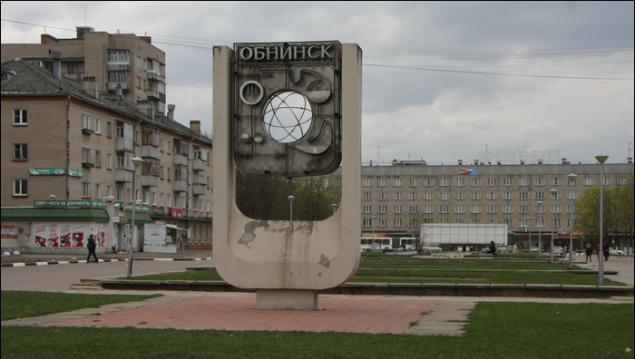
May 16, 1950 Decision of the Council of Ministers of the USSR "On the research, design and experimental work on the use of nuclear energy for peaceful purposes" in the laboratory "B" was given the task to build nuclear power plants with water-cooled. Previously, only reactors designed for producing weapons-grade materials.
The reactor, which is working on the Obninsk Nuclear Power Plant, was named AM. This abbreviation stands for in different ways. In the most common version it says that at first it stood for "Atom sea," that is a reactor for submarines, but then, when this type of reactors considered inappropriate for boats (because of the large size), was called "peaceful atom."
The world's first nuclear power plant was set up in a record even by modern standards, period - since the release of the government's decision before the start it took only four years. The creation of the first nuclear power plant was attended by leading at that time in the field of nuclear physics, scientists Kurchatov, Krasin, Alexandria, Dollezhal (creator of "Chernobyl" RBMK-1000) and others.
The main problem of the creators was that to have a peaceful use of nuclear energy (a term which at the time was not yet popular) no one did - all technologies (choice of material, alloys, their thickness, interaction, connection method) were developed from scratch, and calculations were not carried out on a computer, and brains and slide rule.
The reactor and turbine at the Obninsk Nuclear Power Plant located in different buildings. The steam turbine is supplied to the underground tunnel. Turbine - manufacturing 1930-1940-ies from Germany, trophy.
The reactor of the first Soviet nuclear power plant working on enriched natural uranium in which uranium-235 content was adjusted to 5%. The reactor was located in a steel tank with a diameter of 3 m and a height of 4 to 6 m. It was filled with graphite in the central part thereof was 128 working channel, there fell rods of uranium fuel rods. These rods were surrounded by long graphite cylinder and formed the core diameter of 150 cm and a height of 170 cm.
Reactor operation begins only after it was lowered more than 60 bars. The total loading of uranium in the reactor was 550 kg. Daily consumption of uranium - about 30 grams, the equivalent of 100 tons of coal. Adjusting the power of the reactor was carried out with the help of rods made of boron carbide, actively absorbing neutrons. As the coolant in the primary circuit of the circulating water was used, which had a pressure of 100 atmospheres and a temperature of 280-290 ° C.
In the heat exchanger (steam generator) formed superheated steam at a pressure of 12-13 atmospheres and temperature of 260-270 ° C, power is supplied to the turbine. Full power plant efficiency - 17-19%.
May 9, 1954 in the laboratory started loading the reactor core nuclear fuel channels. When making a 61-channel fuel has been reached a critical state, at 19:40 in the reactor began a self-sustaining chain reaction of uranium fission. There was a physical start a nuclear power plant. Then the reactor was earned at the minimum power.
June 26, 1954 at 17:30 opened the valve on the steam turbine-generator, and the generator is synchronized with the network Mosenergo, giving the power of 1, 5 MW.
"Enjoy Your Bath!" - Congratulated his colleagues Igor Kurchatov.
The next day, industrial and agricultural consumers surrounding areas began to receive electricity from the turbine, the first time in human history works by burning fuel.
Wholly-owned power stations, which for security reasons came in October 1954, was small - 5 MW.
For the first two years of operation of Obninsk NPP spent several kilograms of uranium. Thermal power plant of the same capacity would be burned over the same period more than 75 thousand tons of coal.
On the 5-megawatt nuclear power worked only a few years, the rest of the reactor was used mainly for research purposes.
All calculations and quality of work proved to be such that, launched in 1954, NPP has worked almost half a century and was finally silenced only in 2002, when the reactor was removed last TVEL-assembly. Station worked trouble-free for 18 years over the date originally planned.
Atomic Museum
Since the Russian legislation does not allow for the use of radiation-hazardous formally object the word "museum", the first nuclear power industry recognized the memorial complex, which is still in use behalf of the museum.
Formally, the first nuclear excursions. But come in the usual memorial or museum, buying a ticket, it will not turn. The fact that nuclear power is on the territory of the State Scientific Center of the Russian Federation "Physics and Power Engineering named after AI Leypunsky ", which is engaged in research of nuclear energy, inter alia, for military and space needs. Therefore, the visit must be agreed in advance. I was not allowed to take your video and photo equipment (assuring that they will do for me pictures of their equipment) and the radiometer (in common - the dosimeter).
FEI - serious structure. This can be seen already from the entrance. Concrete blocks at the entrance, strong gates, plenty of surveillance cameras. At the entrance of the bulletproof glass not sit pensioners watchmen and interior troops.
Over the entrance take the bus - the case of NPP is located in the territory of the FEI considerable depth. After a few minutes stop near the famous photographs of the building of industrial architecture of the 1950s with a tall chimney
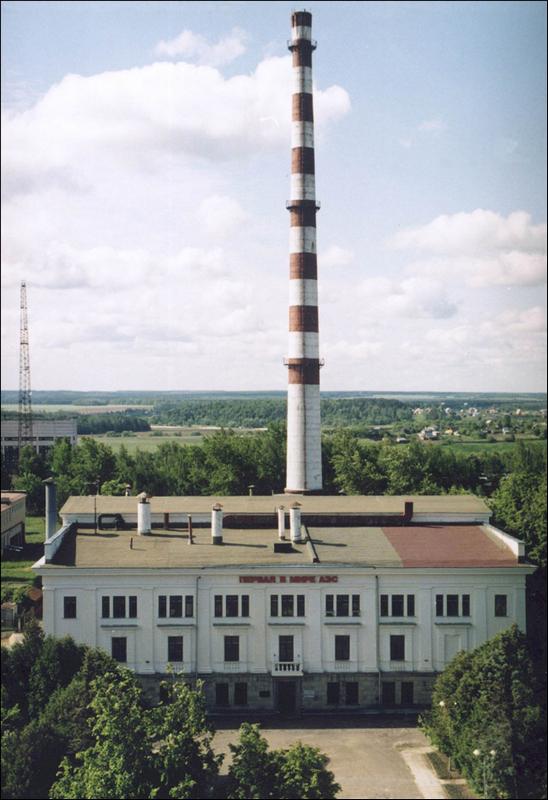
We pass the building. In the wardrobe of all wear white robes, caps and shoe covers - standard clothing for nuclear power plants. In the hallway on the walls - a small museum exhibition of photographs and documents.

In the control room - control, in which no display - only turnouts and lights.

Among other instruments - aviation watches. Part of the equipment is made explicitly for the aviation standards - Black dial with luminous hands. Instead of the usual keyboard - the powerful ebony switches.

***
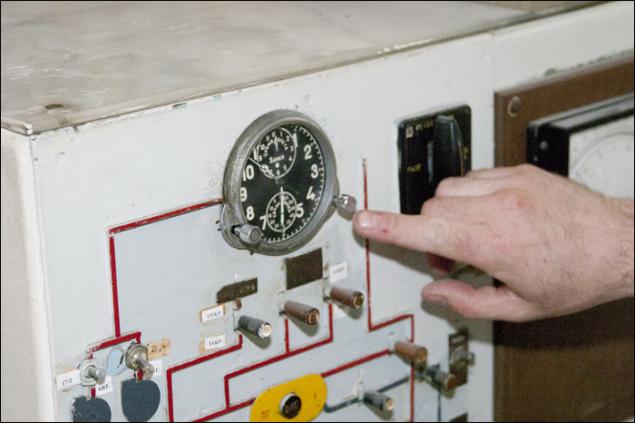
As this is the 60th anniversary of the nuclear power plant in the building there is repair work in the control room on the floor lie FE (fuel elements) of different types of reactors.
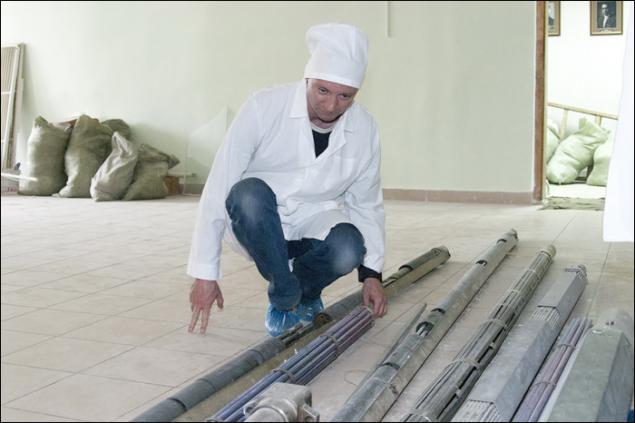
Beautifully shimmer in the light zirconium tubes.

Also here are models of reactors that are used in space.
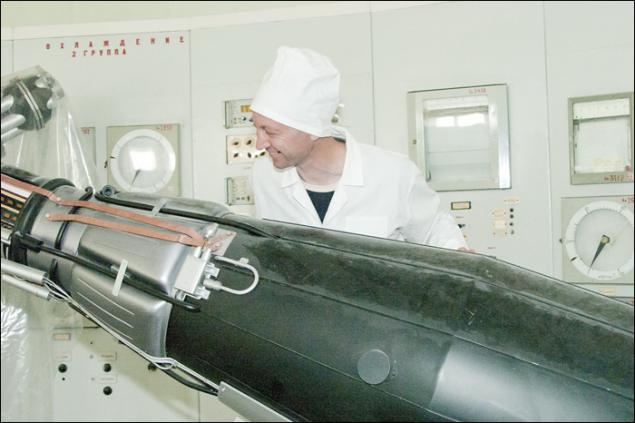
***

Then head to the heart of nuclear power - in the reactor hall. The lid of the reactor is at ground level, and the reactor foundation go to a depth of 14 meters.
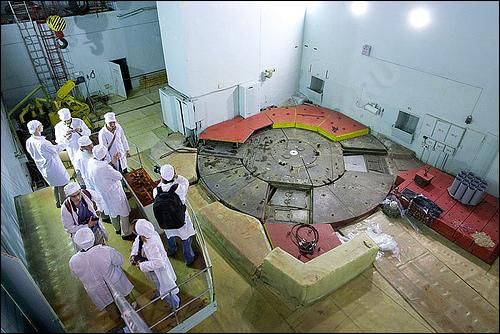
Passage in the reactor hall resembles a fortification - thick concrete walls, control panel with a small round portholes made of glass with a high lead content. The thickness of the glass is about 20 cm. It was carried out by replacing the management of fuel elements
understand the purpose of the device helps
Director Andrew Jurin first nuclear power plant (left)

***
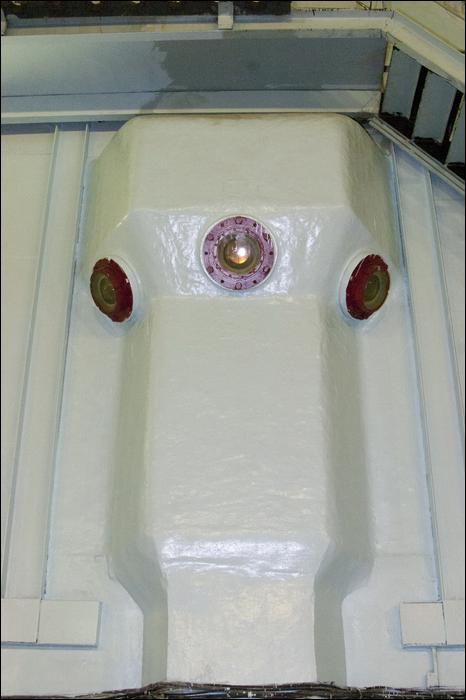
***
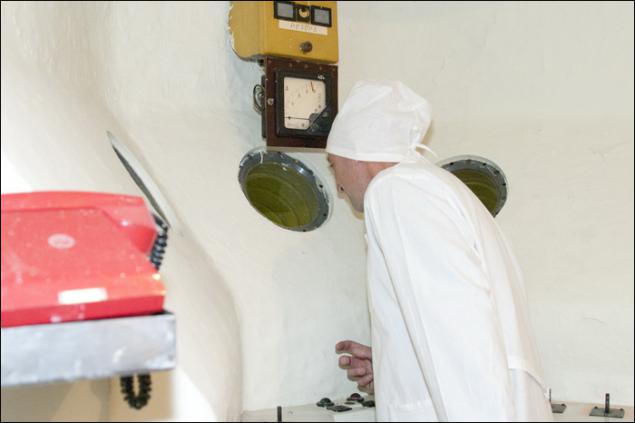
In the hall several workers in white suits changed flooring. Normally, visitors are not allowed on (majority and does not seek to), but I made an exception.

Go down the hall. By modern standards, a small room, the length of the walls - a few tens of meters below the ceiling hangs a powerful block of the crane. Himself radiophobia not suffer, but in the reactor hall feel the excitement. Perhaps because of the thick concrete walls, insulating the hall from the outside world.
According to the head of NPP, is now in the hall above the natural background level is about three times. This is where a 36 mR / hr. For comparison - in the vicinity of the research station Masan in Belarus, 14 kilometers from Chernobyl, where a rotational basis live and work in the Belarusian scientists, the background level up to 5000 mR / h and above.
I was even allowed to stand on the lid of the reactor, saying that so I was the first journalist who was at the reactor in the world's first nuclear power plant. To consolidate the success I sat on it a little bit.

We leave the reactor hall, and head to the office of the NPP. Here, carefully preserved environment 1950s. Chief nuclear writes memorable visitor certificate. On this tour is over ...
***
The world's first nuclear power plant - the most famous sites in Obninsk.
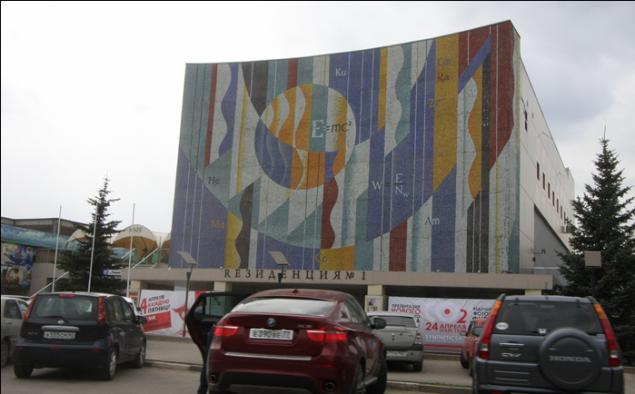
Buildings in the old part of the town of Obninsk reminds military. Pines, low-rise brick homes of officers, usually yellow in some places - wooden huts and high fences, through which it is not recommended climbeth.
VUNTS Navy Training Center "Naval Academy»,
where prepare crews for the nuclear submarine fleet

The building of the city administration of Obninsk
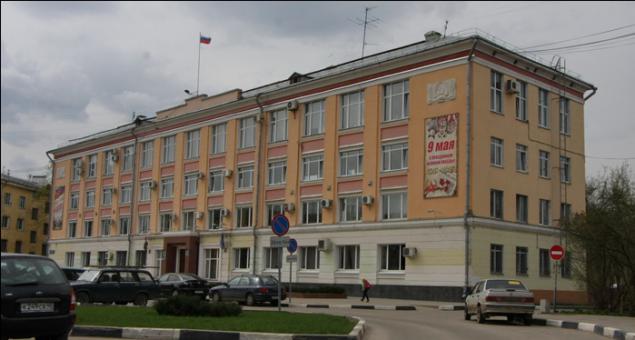
***
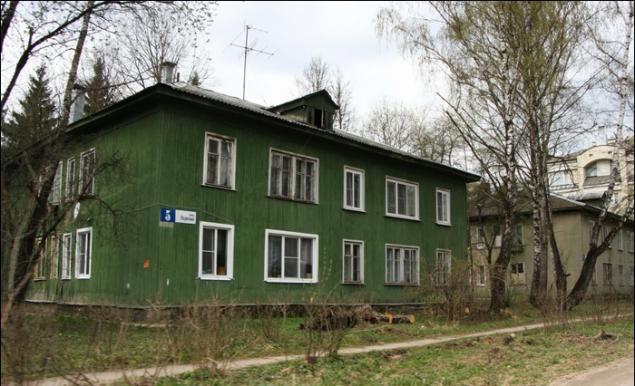
Despite the distance from the sea, on the streets of Obninsk many sailors - there is a center for training crews of Russian nuclear submarines.

***
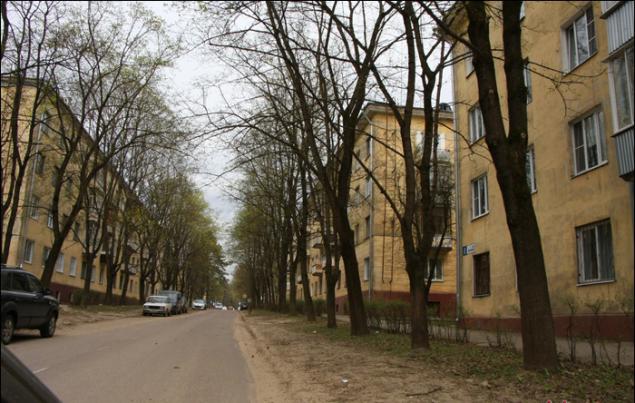
***

Another symbol of the city - is taken up to a height of 310 meters (almost like the Eiffel Tower) tower. It was built in 1958 for the study of radioactive particles in the atmosphere, and today is used by forecasters.
that's all, thank you for your attention

Source:
Yet not all the war-torn towns and villages rose from the ruins, and a few hundred kilometers from Moscow has already begun construction of the first nuclear power plant in the world.
25 photo source.

As the "sea" atom was "peaceful»
Initially Obninsk near the station 105 km from Moscow on the Moscow-Kiev railroad in the mid-1940s there Laboratory "B", engaged in the research of nuclear energy. Over time, the laboratory was the Physics and Power Engineering (FEI), and the station - the city of Obninsk.

May 16, 1950 Decision of the Council of Ministers of the USSR "On the research, design and experimental work on the use of nuclear energy for peaceful purposes" in the laboratory "B" was given the task to build nuclear power plants with water-cooled. Previously, only reactors designed for producing weapons-grade materials.
The reactor, which is working on the Obninsk Nuclear Power Plant, was named AM. This abbreviation stands for in different ways. In the most common version it says that at first it stood for "Atom sea," that is a reactor for submarines, but then, when this type of reactors considered inappropriate for boats (because of the large size), was called "peaceful atom."
The world's first nuclear power plant was set up in a record even by modern standards, period - since the release of the government's decision before the start it took only four years. The creation of the first nuclear power plant was attended by leading at that time in the field of nuclear physics, scientists Kurchatov, Krasin, Alexandria, Dollezhal (creator of "Chernobyl" RBMK-1000) and others.
The main problem of the creators was that to have a peaceful use of nuclear energy (a term which at the time was not yet popular) no one did - all technologies (choice of material, alloys, their thickness, interaction, connection method) were developed from scratch, and calculations were not carried out on a computer, and brains and slide rule.
The reactor and turbine at the Obninsk Nuclear Power Plant located in different buildings. The steam turbine is supplied to the underground tunnel. Turbine - manufacturing 1930-1940-ies from Germany, trophy.
The reactor of the first Soviet nuclear power plant working on enriched natural uranium in which uranium-235 content was adjusted to 5%. The reactor was located in a steel tank with a diameter of 3 m and a height of 4 to 6 m. It was filled with graphite in the central part thereof was 128 working channel, there fell rods of uranium fuel rods. These rods were surrounded by long graphite cylinder and formed the core diameter of 150 cm and a height of 170 cm.
Reactor operation begins only after it was lowered more than 60 bars. The total loading of uranium in the reactor was 550 kg. Daily consumption of uranium - about 30 grams, the equivalent of 100 tons of coal. Adjusting the power of the reactor was carried out with the help of rods made of boron carbide, actively absorbing neutrons. As the coolant in the primary circuit of the circulating water was used, which had a pressure of 100 atmospheres and a temperature of 280-290 ° C.
In the heat exchanger (steam generator) formed superheated steam at a pressure of 12-13 atmospheres and temperature of 260-270 ° C, power is supplied to the turbine. Full power plant efficiency - 17-19%.
May 9, 1954 in the laboratory started loading the reactor core nuclear fuel channels. When making a 61-channel fuel has been reached a critical state, at 19:40 in the reactor began a self-sustaining chain reaction of uranium fission. There was a physical start a nuclear power plant. Then the reactor was earned at the minimum power.
June 26, 1954 at 17:30 opened the valve on the steam turbine-generator, and the generator is synchronized with the network Mosenergo, giving the power of 1, 5 MW.
"Enjoy Your Bath!" - Congratulated his colleagues Igor Kurchatov.
The next day, industrial and agricultural consumers surrounding areas began to receive electricity from the turbine, the first time in human history works by burning fuel.
Wholly-owned power stations, which for security reasons came in October 1954, was small - 5 MW.
For the first two years of operation of Obninsk NPP spent several kilograms of uranium. Thermal power plant of the same capacity would be burned over the same period more than 75 thousand tons of coal.
On the 5-megawatt nuclear power worked only a few years, the rest of the reactor was used mainly for research purposes.
All calculations and quality of work proved to be such that, launched in 1954, NPP has worked almost half a century and was finally silenced only in 2002, when the reactor was removed last TVEL-assembly. Station worked trouble-free for 18 years over the date originally planned.
Atomic Museum
Since the Russian legislation does not allow for the use of radiation-hazardous formally object the word "museum", the first nuclear power industry recognized the memorial complex, which is still in use behalf of the museum.
Formally, the first nuclear excursions. But come in the usual memorial or museum, buying a ticket, it will not turn. The fact that nuclear power is on the territory of the State Scientific Center of the Russian Federation "Physics and Power Engineering named after AI Leypunsky ", which is engaged in research of nuclear energy, inter alia, for military and space needs. Therefore, the visit must be agreed in advance. I was not allowed to take your video and photo equipment (assuring that they will do for me pictures of their equipment) and the radiometer (in common - the dosimeter).
FEI - serious structure. This can be seen already from the entrance. Concrete blocks at the entrance, strong gates, plenty of surveillance cameras. At the entrance of the bulletproof glass not sit pensioners watchmen and interior troops.
Over the entrance take the bus - the case of NPP is located in the territory of the FEI considerable depth. After a few minutes stop near the famous photographs of the building of industrial architecture of the 1950s with a tall chimney

We pass the building. In the wardrobe of all wear white robes, caps and shoe covers - standard clothing for nuclear power plants. In the hallway on the walls - a small museum exhibition of photographs and documents.

In the control room - control, in which no display - only turnouts and lights.

Among other instruments - aviation watches. Part of the equipment is made explicitly for the aviation standards - Black dial with luminous hands. Instead of the usual keyboard - the powerful ebony switches.

***

As this is the 60th anniversary of the nuclear power plant in the building there is repair work in the control room on the floor lie FE (fuel elements) of different types of reactors.

Beautifully shimmer in the light zirconium tubes.

Also here are models of reactors that are used in space.

***

Then head to the heart of nuclear power - in the reactor hall. The lid of the reactor is at ground level, and the reactor foundation go to a depth of 14 meters.

Passage in the reactor hall resembles a fortification - thick concrete walls, control panel with a small round portholes made of glass with a high lead content. The thickness of the glass is about 20 cm. It was carried out by replacing the management of fuel elements
understand the purpose of the device helps
Director Andrew Jurin first nuclear power plant (left)

***

***

In the hall several workers in white suits changed flooring. Normally, visitors are not allowed on (majority and does not seek to), but I made an exception.

Go down the hall. By modern standards, a small room, the length of the walls - a few tens of meters below the ceiling hangs a powerful block of the crane. Himself radiophobia not suffer, but in the reactor hall feel the excitement. Perhaps because of the thick concrete walls, insulating the hall from the outside world.
According to the head of NPP, is now in the hall above the natural background level is about three times. This is where a 36 mR / hr. For comparison - in the vicinity of the research station Masan in Belarus, 14 kilometers from Chernobyl, where a rotational basis live and work in the Belarusian scientists, the background level up to 5000 mR / h and above.
I was even allowed to stand on the lid of the reactor, saying that so I was the first journalist who was at the reactor in the world's first nuclear power plant. To consolidate the success I sat on it a little bit.

We leave the reactor hall, and head to the office of the NPP. Here, carefully preserved environment 1950s. Chief nuclear writes memorable visitor certificate. On this tour is over ...
***
The world's first nuclear power plant - the most famous sites in Obninsk.

Buildings in the old part of the town of Obninsk reminds military. Pines, low-rise brick homes of officers, usually yellow in some places - wooden huts and high fences, through which it is not recommended climbeth.
VUNTS Navy Training Center "Naval Academy»,
where prepare crews for the nuclear submarine fleet

The building of the city administration of Obninsk

***

Despite the distance from the sea, on the streets of Obninsk many sailors - there is a center for training crews of Russian nuclear submarines.

***

***

Another symbol of the city - is taken up to a height of 310 meters (almost like the Eiffel Tower) tower. It was built in 1958 for the study of radioactive particles in the atmosphere, and today is used by forecasters.
that's all, thank you for your attention

Source:
Tags
See also
Inventions of the USSR
The very first nuclear power plant in the world!
How does a nuclear power plant
The first atomic
Conversation with astronaut: health, weightlessness and space mutants
Fourth generation
The first geothermal station was built in the Chechen Republic
Indonesia will build the world's largest geothermal power station
9 the strangest railway stations in the world
The most terrible nuclear disaster in the history of mankind (72 photos)

















